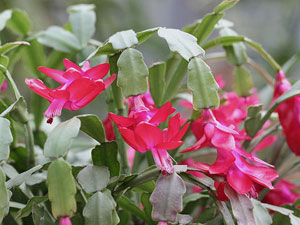Flower maintenance and care
Schlumbergers do not tolerate excessive moisture or drying out. But from my own experience I will say: it is better to dry than to pour. A dried-up flower recovers much better than a flooded one. Most often, the only salvation of a flooded flower is to cut off segments of its leaves and root again, because the roots quickly rot.
Schlumberger life cycle chart at home
| Months Cycle | Lighting | Humidity, watering | Temperature | Additionally |
| September-October | A little shading | Watering is rare, as the soil dries out. It is not necessary to spray. | Decrease to + 15-18. You can leave on the balcony, but do not allow below +15! | Fresh air, but not drafts. In October, feed 1 time with complex fertilizer for cacti. |
| November-January Flowering period | Diffused light | High humidity. Spray. Watering regularly. Do not allow the soil to dry out completely. | +18–22 | Fertilizing with fertilizer for flowering twice a week or once every ten days with fertilizer for cacti. Do not change the conditions of detention and turn the flower. |
| February-March | A little shading | Moderate watering | +15–18 | Pinch off the end segments to form a crown. Fertilize once with cactus fertilizer. |
| March - September Vegetation period | Diffused light | Regular watering | +18–20 | Application of complex fertilizers 1 time in 2 weeks. Airing. If necessary, transplant. |
| June-August Vegetation period, preparation for rest. | Diffused light | Spray regularly with warm water. Arrange a warm shower. Watering regularly | +18–25 | Keep outdoors or ventilated Fertilize biweekly with cactus fertilizer. |
Not every florist has the desire and time to comply with the maintenance regime according to the scheme. If your Decembrist grows on your window, then you can not arrange his rest time. The main thing is to know the basic conditions necessary for it:
- Temperature. The Decembrist does not like either cold or heat. The best temperature for him is room temperature, without sudden fluctuations, not lower than + 15 degrees and not higher than + 25 degrees. It can withstand a short-term temperature drop up to + 5 degrees. At temperatures below + 12 degrees, flower buds do not lay.
- Fresh air. The Decembrist needs fresh air. Air it out. With the beginning of spring, the flower can be taken out to the balcony. Doesn't like drafts.
- Moisture, spraying. Humidity is required high enough, because in nature this flower receives moisture not only through the roots, but also through the leaves and air roots.
If kept cool, do not spray during the rest period. At any other time, you can spray the leaves even during flowering. The main thing is that the water is soft and warm. You can use boiled.
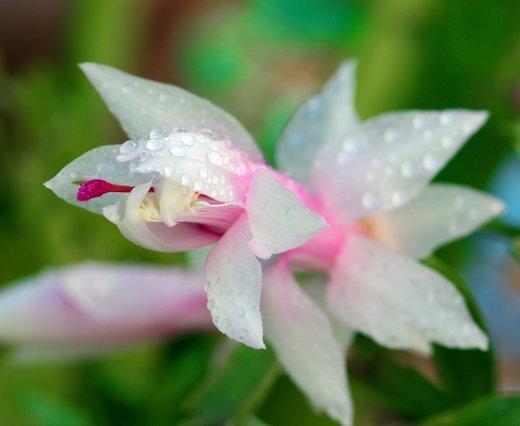
Decembrist flowers are not afraid of water
Do not pour too much water when watering. Use only warm and settled (about a day) water. If your water is hard and with impurities, then pour it filtered or, in extreme cases, boiled.
If you dry out the plant and its leaves shriveled, then water and spray it. It will quickly regain its healthy appearance. But of course, if you dried a large Decembrist so that all the roots are dry, then it is better to pinch off the branches and plant again.
- A change of scenery. Schlumberger does not tolerate drastic climate change. In no case change the orientation of the Decembrist during flowering, otherwise the flowers and buds may fall off. You can move it without turning it towards the light.But it is best to wait until the end of flowering.
- Clean leaves. Schlumberger in nature receives food and water mainly from air roots and leaves. Therefore, it is necessary to ensure that the leaves are clean from dust. You can wipe them with a damp cloth or sponge. After wiping or showering, you can walk over the leaves with the back of a banana peel or yolk diluted in water. This is also additional food.
Ripsalidopsis diseases and pests
Frequent spraying can lead to fungal diseases. Fungal spores love moisture and can settle on roots and leaves. Their manifestation and development can be noticed by uncharacteristic spots on the fleshy green part of the plant. They have a weeping character. To fight the fungus, you will have to use a fungicide. In this case, you need to inspect the roots, remove the rotten ones and process them with potassium permanganate. A diseased plant must be removed from the rest, otherwise the entire collection may become sick.
Among pests that like to settle on the underside of the leaf, mites and mealybugs are especially dangerous. They can be seen when examining pets. Spraying with the right medicine is suitable for the fight. You can use a soapy solution (be careful not to burn the fabric).
When treating a bush, care must be taken to ensure that medicinal solutions do not get into the soil. All tools must be processed after working with a diseased flower. The place where the pot stands can be wiped with whiteness.
Let us consider in detail the causes of diseases and methods of their treatment.
| Causes | Signs of defeat | Ways to fight |
| Shields | Ticks form light brown, shield-like spots on the leaf surface. | You should try to wipe the sheets with a damp cloth to remove visible pests. It will also require spraying with a scabbard agent. |
| Mealybugs | White sticky fluff is noticeable on the shoots. | All affected parts are also wiped with a cloth and sprayed with an insecticidal agent. |
| Spider mites | A small thin cobweb is noticeable on the bush, on which red dots move. | It is necessary to use acaricide, repeat the treatment several times. |
| Late blight | This viral disease is manifested by the appearance of unusual brown-blue spots. With the course of the disease, they increase, destroying the shoots. | A sick cactus is removed from the rest of the plants, the affected parts are cut off and eliminated. Spray the bush with "Topaz" or another fungicide. If the treatment does not give results, it is better to throw away the diseased specimen without regretting it, until it has infected other plants. |
| Fusarium | It is also a viral disease that is difficult to treat. At first, the lashes turn yellow at the tips, and then brown at the base. | The infected plant must be quarantined. Use fungicides. If they do not help, they eliminate it together with the soil and the pot. |
Decembrist: home care
Being not a very demanding crop in terms of cultivation, the Brazilian cactus prefers regular and attentive care, with strict adherence to all agrotechnical regimes.
Lighting and placement
Under natural conditions, the Decembrist grows under a canopy of tree branches, therefore, genetically does not tolerate the prolonged influence of the hot rays of the sun. Bright lighting is one of the reasons why the leaves of the Decembrist turn red.
But without sufficient daylight hours, the cactus will not receive the necessary conditions for the formation of buds.
Important! Optimal for Decembrist is considered to be the location on the western and eastern windows, where a suitable light activity is created and direct sunlight is excluded. The southern windowsills are also suitable, provided that the plants are shaded in the summer noon hours.
On the windows of the north side, for the Decembrist, a lack of lighting is guaranteed, so you should consider additional illumination with fluorescent lamps. In this case, the question of how to make the plant bloom in due time will be resolved.
The southern windowsills are also suitable, provided that the plants are shaded in the summer noon hours. On the windows of the north side, for the Decembrist, a lack of lighting is guaranteed, so you should consider additional illumination with fluorescent lamps. In this case, the question of how to make the plant bloom in due time will be resolved.
Temperature regime
Suitable for Decembrist are thermometer readings within +17 + 22 ° С. This temperature must be maintained throughout the spring and summer period.
With the approach of cold weather, the temperature should be slightly (by 2-3 degrees) lowered to create a comfortable environment for the Decembrist for the formation of buds. During blooming, these temperatures will increase the flowering period.
Attention! It is necessary to protect the cactus from sudden temperature changes, since drafts and hypothermia can disrupt the flowering schedule of the Decembrist. It is the violation of the temperature regime that is the main reason why the cactus does not bloom
After the flowers fall, the plant needs a mandatory rest: it must be transferred to a cool room with optimal lighting.
Requirements for soil and feeding
The root system of the Decembrist is poorly developed, therefore, the substrate for the plant should be selected nutritious, light, with good aeration and water permeability.
During the entire active growing season, Zygocactus must be fed monthly with a solution of mineral fertilizers.
Attention! It is forbidden to fertilize recently transplanted or diseased specimens
Watering mode
Each subsequent watering is carried out after a little drying of the upper part of the earthen substrate.
Regular and moderate soil moistening is one of the main rules of how to care for the Decembrist so that it blooms at the time it is supposed to. Drainage at the bottom of the flowerpot is also required to protect the roots from rot.
Transfer
The Decembrist has a negative attitude to any interference in the processes of his life. This also applies to transplanting a cactus. When deciding how to transplant a plant, it is advisable to give preference to the transshipment method.
Young plants, due to their rapid growth and development, require annual replacement of the flowerpot and substrate. Older specimens can grow in one pot for about five years.
Advice! The health of the root system of the Decembrist, which means the well-being and decorativeness of the whole plant, depends on the presence of a drainage layer at the bottom of the flowerpot.
Pruning
For Schlumberger, a pruning procedure is essential. It stimulates the branching of the stems of the plant, which promotes the establishment of more buds on the newly formed shoots and more lush flowering.
Pruning of the Decembrist is done after the last flower has dried: you should manually remove all dried corollas and remove part of the young growth along the line of articulation of the stem segments.
This video shows you how to prune a Decembrist for a lush bloom.
Rhipsalidopsis reproduction
Reproduction methods: grafting, grafting, seed method.
Reproduction is very easy with stem cuttings. For this purpose, two or three segments are separated from the shoot in a circular motion, they are left in outdoor conditions for two to three days so that they dry out. A stalk is installed in a container filled with a moist soil mixture, and it does not deepen, but simply leans against any support. The appearance of roots in the cuttings will occur quite soon, and it can already be planted in the soil substrate.
Grafting of this culture is carried out on the stem of "Pereskia prickly", grafting is carried out in the summer. At the pereskia, the apical branching part with all the leaves is cut off, so that only a bare stem remains
Its tip is gently split. For the scion, a shoot is taken, which consists of two or three segments, its tip needs to be sharpened so that it becomes wedge-shaped
With a sharp tip, the shoot is inserted into the split place.After that, the graft is secured with a thorn, a long thorn or a needle. Then it is wrapped, for this purpose a thread or a plaster is taken. Then the container is placed in a room with temperature conditions within eighteen to twenty degrees. The scion will grow together in fifteen days, after which growth will begin. Next, the bandage is removed, after the branches or leaves appear at the bottom, they must be cut off immediately. This vegetation has a very abundant flowering.
To cultivate a cactus of this species is quite simple by seed method. To get them, you need 2 adult plants, unrelated to each other (different varieties or varieties are used). You need to take the pollen from the flowers of one cactus with a brush and transfer it to another. At the end of flowering, the fruit will appear in the form of a reddish berry. Ripening of the berry takes quite a long time, and only after shrinking it can be picked.
The germination capacity of the seeds is maintained for several years. Sowing of grains is carried out in a wide container, a soil substrate is poured into it, which consists of leafy soil and sand, taken in equal proportions. The grown plants are transplanted in separate containers. Moreover, it is advisable to plant several plants at once in one container in order to get the most lush bouquet.
Reproduction of Ripsalidopsis at home
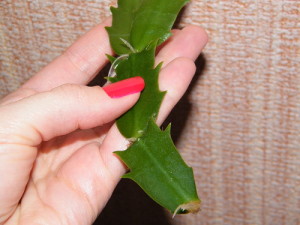
You can propagate Ripsalidopsis by cuttings and seeds.
Ripsalidopsis can be propagated in two ways - using cuttings and seeds. To obtain seeds, it is necessary to collect pollen from the inflorescences of a plant with a brush and transfer it to another, unrelated to it. It is allowed to take different varieties and types. After the end of the flowering period, fruits are formed. After a while, seeds are taken from the ripe fruits and planted in a spacious container. After germination, the plants can be replanted. To obtain a dense bush, it is allowed to place several shoots in one pot.
Ripsalidopsis have aerial roots to absorb additional moisture from the air. Therefore, propagation by cuttings is very convenient. The stem plate must be broken off at the junction with the adjacent segment, preferably in order to obtain a process with two or three segments. Plant the stalk in a small pot, water a little and put in the shade. Ripsalidopsis will take root in a few days. To get a more lush plant with different flowers, you can plant several cuttings of different varieties in one flowerpot.
Problems with home keeping ripsadilopsis
Like many flowers, Ripsalidopsis is susceptible to several diseases.
The defeat of a bacterial infection is accompanied by the decay of a separate part of the plant. A slippery spot forms at this point. The damaged area must be repaired. If the trunk is infected, the flower must be transplanted into another pot, removing the infected part.
Damaged plant stems can be affected by a fungal infection - fusarium. Fungicides are used to treat the plant.
Rhipsadilopsis, like other indoor plants, is susceptible to diseases and pests.
Infection with phytium and phytophthora occurs through contaminated soil. The disease affects the roots of Ripsalidopsis. The main symptom of an infestation is the wilting of the plant when there is enough moisture. The color of the stems becomes dull and grayish. Antifungal drugs are used for treatment.
Pests are also the cause of Ripsalidopsis diseases.
When infected with a spider mite, small colorless dots appear on the stems, increasing over time. On the back of the stem plates, a cobweb forms, in which mites multiply. The plant begins to weaken and wither. To combat the pest, Ripsalidopsis must be treated with alcohol or hot water
The root system and the outer part are affected by the mealybug.A bloom begins to appear on the plant, similar to a dense wax web or cotton wool. In this case, it is necessary to transplant Ripsalidopsis into new soil by washing the roots with a solution of potassium permanganate, and alcohol, calendula tincture or special chemicals are suitable for treating the stems.
It is difficult to determine the damage to the plant by scale insects in the early stages. But if you look closely, the parasites can be seen. They look like fast-moving specks. Over time, brown seals and a sticky liquid develop on the stems, in which soot fungus can appear and further aggravate the situation. To destroy the parasite, the plant is treated with alcohol or insecticide.
For the prevention of diseases and the appearance of pests, the stems of Ripsalidopsis must be periodically wiped, remove dried stems, and prevent the creation of a favorable environment for the appearance of parasites.
Rhipsalidopsis, like all plants belonging to the cactus family, is an excellent absorber of negative influences. If the plant is not sick and feels good, it forms an energy cycle. Energy fluctuations in Ripsalidopsis are wave-like. It is concentrated at the base of the plant and emerges from it like fountains, rising and falling.
Rhipsalidopsis will decorate any room, its long stems will look great in a hanging planter, and bright flowers will create a mood and fill the room with a delicate aroma. By purchasing a plant, you can be sure that its powerful energy will protect against negativity, negative emotions and have a positive effect on the home atmosphere.
How to distinguish a Schlumberger cactus from Ripsalidopsis, appearance
|
|
|
Schlumberger (Decembrist) |
Everyone knows that a cactus is prickly, rarely blooms ... And although there are terribly cute among them, it is
plant for an amateur.
But in fact, not all cacti are pricked, there are also leafy ones, or in another way they are called - forest. This team includes
plants that live in almost every home are the sansevieria and the bastard, popularly known as the money tree.
The most beautiful leafy cacti are flowering. This is where the confusion begins.
In winter, the Decembrist blooms, but this is a popular name, and the scientific name is Schlumberger. This plant is also a leafy cactus. He
rather unpretentious, he has few complaints: a bright place, slightly shaded from direct sunlight,
the air temperature is about 20 degrees. However, during the budding period, Schlumberger becomes capricious. If at this time
rearrange it to another place, then it will instantly drop the buds, and it simply will not come to flowering. Right now in
Plants very similar to the Decembrist appeared on sale. For example, ripsalidopsis. Although it is a related plant, but
still different.
Do you know what the difference is? Schlumberger why the Decembrist? Because it blooms in December. A ripsalidopsis the Decembrist
it cannot be, because it blooms in spring. In the West, they say about them that the first blooms for Christmas, and the second - for
Easter.
Outwardly, these plants differ in segments - in Schlumberger they are light green with rounded or toothed
protrusions at the edges, and the flowers are almost radially symmetrical. Ripsalidopsis has no denticles on the segments and a marginal
scalloped, and flowers with a short, unbent tube.
|
|
|
Rhipsalidopsis |
Since October, a real Decembrist should be given a rest period and placed in a bright and cool place, where the temperature
air will be a maximum of 8 ° C. It does not need to be watered for six weeks. At the beginning of December will begin to appear
buds - abundant watering is needed at this time.
After flowering (in February), the plant must be transplanted into a soil mixture for cacti and watered until about September
moderately. They begin to feed one month after the transplant and do it until September (once every two weeks)
fertilizer for cacti.
Ripsalidopsis care is the same as for the Decembrist, only all these operations are done at a different time: from March to
September is watered abundantly, then from mid-September to mid-December the plant lives in Spartan conditions,
with little or no watering. But by the beginning of March they begin to drink him. After flowering, Ripsalidopsis is transplanted into
soil mixture for cacti, and after a month you can already feed.
Spartan conditions (coolness and lack of water) are necessary for the budding of flower buds, otherwise you will not see beauty.
Y. Vasilieva
Return to the table of contents - Tips ...
Rhipsalidopsis and Schlumberger or does the Decembrist bloom in spring
Sometimes the owners of the Decembrist claim that their pet blooms in March-April, showing photographs as evidence. If you look closely at the plant in the image, then most often it turns out that instead of Schlumberger, another epiphytic cactus, Ripsalidopsis, outwardly very reminiscent of a Decembrist, has dissolved its bright red flowers in a pot. It is also called the Easter star, since it is in April that the peak of its bloom is observed. <? P?>
Although among the Decembrists now you can find more than one variety. As a rule, on our windowsills they bloom:
- schlumberger truncated (truncatus) and
- another hybrid is the Schlumberger bucklei or bucklei.
Take a look at the photo, it is noticeable that the plants differ in the shape of the stem segments. In Ripsalidopsis, their edges are smoothed and rounded, in S. buckley - more pronounced, and in S. truncated - sharply serrated.
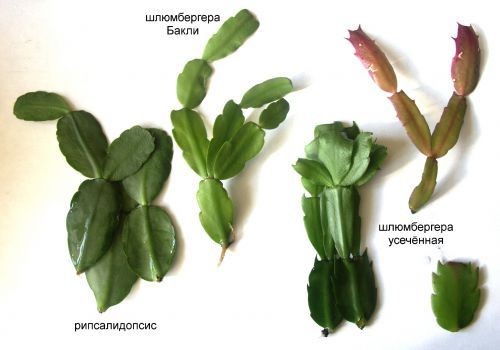
And in this photo, we note the difference not only in the appearance of the segments, but also in the structure of the flower.
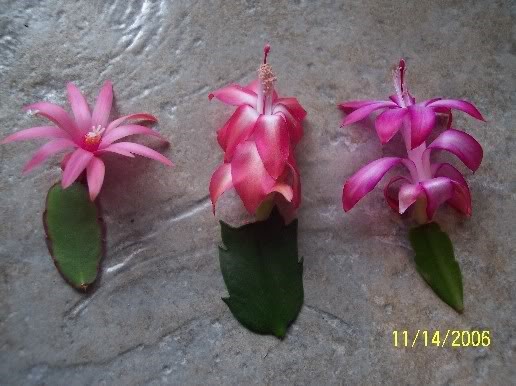
On the left - Ripsalidopsis, in the center - Sh. Truncated, on the right - Sh. Bouclei.
If in both species of Schlumberger there is a bilateral symmetry of the flower, it is slightly truncated, then in Ripsalidopsis the inflorescence is radially symmetric and looks like a pointed star.
Summarizing what has been said, we can draw the following conclusion: in November - January, Schlumberger bouclei (the so-called "grandmother's Decembrist") blooms, in December-February she passes the baton to the Truncated Schlumberger, and in the spring we admire the flowering of Ripsalidopsis.
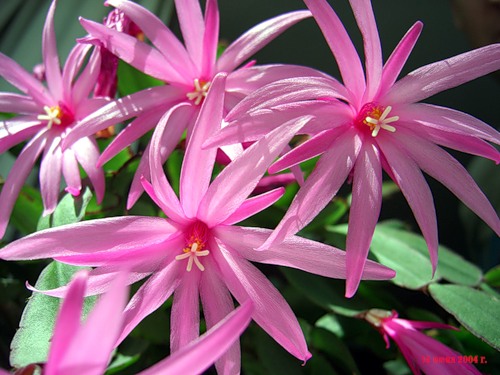 |
| Rhipsalidopsis |
Someone will object: how to evaluate the flowering of zygocactus, which we observe in garden centers throughout the year, including at the height of summer? It's very simple: it is the result of modern greenhouse equipment, where you can create any conditions for forcing and lush flowering at the right time of the year. <? P?>
What it is?
Rhipsalidopsis is a plant from the Cactaceae family, the name of which literally translates as "whip-like berry cactus". The people also often use the names Easter Egg, Easter Cactus or Forest Cactus. Sometimes Ripsalidopsis is confused with Schlumberger, but, in fact, they are completely different members of the family. But it is very easy to distinguish it from an ordinary cactus, because the characteristic features of the plant are the absence of thorns and dense skin.
In nature, zygocactus develops not on the ground, but on trees, including sick or old ones. A different plant in this sense is only a support contributing to a better and more efficient development of the root system. Cactus accumulates moisture and useful elements in unusual thickened stems, which are divided into wide leaf-shaped plates. Throughout the entire growth process, some of them are outweighed over the edge of the container.

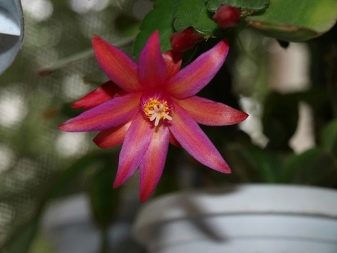
Although the flowering process itself lasts up to two months, the lifespan of an individual inflorescence is no more than a couple of days. The diameter of the opened bud varies from 5 to 8 centimeters, and from 1 to 3 specimens are formed on each shoot. The petals of the flower are very neat and narrowed, with a sharp tip, which makes the opened flower look like a beautiful star. They can be painted in scarlet, burgundy or white. Although the color palette is not very wide, each shade looks very rich and tasty.
The height of the bush reaches 30 centimeters, moreover, it is characterized by sufficient branching. Some stems are 5 centimeters long and can be up to 3 centimeters wide. Usually, a cactus is painted in a light salad shade, but after being exposed to prolonged exposure to sunlight, it can change its color to a variety of red. The top of the ripsalidopsis is crowned with a collection of axillary buds, from which a bunch of whitish bristles grow. After the cactus has finished flowering, the buds are replaced by soft fruits, painted in a pale red hue and resembling a pentahedron.

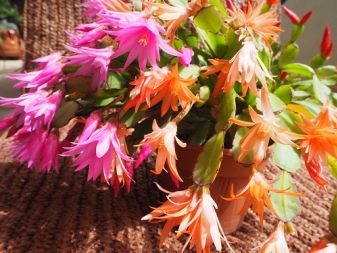
Soil for flattering cacti
In nature, Schlumbergers are epiphytes that grow in crevices in the bark of trees. Therefore, the soil for planting the Decembrist at home should be as loose, moisture and air permeable as possible.
A proven recipe for soil composition for zygocactus: leafy earth + coarse sand in a 1: 1 ratio. It is recommended to use a small amount of charcoal and peat as an additive to this mixture.
Schlumberger transplant is carried out every 1-2 years. This is done not immediately after flowering, but during the resumption of growth (the beginning of the growing season) - from mid-March to the end of April.
For transplantation, a pot is selected 2 cm larger in diameter than the previous one. The pot may be small in height, since the root system of zygocactus is superficial and does not go deep into the ground. Drainage holes and a drainage layer (expanded clay, polystyrene, pieces of broken brick), 2-3 cm thick are required.
The Schlumbergers talk about the transplant in the video:
general description
What is the scientific name?
Schlumberger or in Latin Schlumbergera is a representative of the genus of epiphytic tropical forest cacti that grows in the South-East of Brazil. This plant got its articulatory difficult name in 1858 from Charles Lemaire, a French botanist and writer. He gave the name to this marvelous plant in honor of the French succulent collector Frederic Schlumberger.
In addition, this plant has broad synonyms.
- A common name is Zygocactus (Latin Zygocactus), given by Karl Schumann, a German botanist.
- The German botanist and gardener Alvin Berger called Schlumberger Epiphyllanthus.
- German zoologist, botanist and doctor Ludwig Pfeiffer called this succulent "Epiphyllum", however, it is worth noting that a quarter of a century earlier, Adrian Haworth, an English botanist, also called it.
- The Czech botanist and ethnographer Alberto Fritsch, together with Kurt Kreuzinger, a German botanist, called this natural wonder "Zigocereus".
Apart from Zygocactus and others, Schlumberger has various less scientific names. They were given in connection with the flowering periods of the plant. The fact is that it blooms in November, December and January. Hence the nicknames: "Decembrist or Decembrina", "Christmas" and even "Christmas cactus". Also, based on visual similarity, this plant is called "crab cactus". Yes, in such a seemingly unfavorable period, Schlumberger blooms and smells.
Botanical characteristics
According to the scientific classification of Schlumberger, it belongs to:
- Domain: eukaryote.
- Kingdom: plants.
- Department: flowering.
- Class: dicotyledonous.
- Above the order: caryophyllan.
- Order: clove.
- Family and subfamily: cactus.
- Tribe: ripsalis.
- Rod: Schlumberger.
What does Schlumberger look like?
The Schlumberger genus is represented by actively branching shrubs. This forest tropical cactus grows up to 32-40 centimeters in height. The shoot is represented by a chain of segments 4-7 centimeters long, hanging from the root to the ground. These segments are green, dense in structure, without spines, but with hooks along the edges and hairs on the surface.
ATTENTION: The shoots are crowned with a zygomorphic inflorescence with a pronounced tube. Flower petals can be white, pink, yellow, orange, pale purple or red.
The rest of the external characteristics are individual for different species.
Homeland of Zygocactus
Schlumberger was discovered in the South-Eastern rainforests of Brazil, coastal areas and rocky areas. All growth zones of this succulent are distinguished by high humidity. Also, specimens were found in the areas of Rio de Janeiro or São Paulo at elevations from 900 to 2800 meters. Schlumberger grew on the root system of trees, rock crevices or even branches, and its shoots hung like vines.
Schlumberger was introduced to Europe in 1816 by Allan Cunningham, a botanist from England. And since 1818, the plant has already been actively cultivated. In 1852, hybrids were massively bred using these succulents. And by 1860, there were already a sufficient number of varieties in widespread use and use.
At the moment, the Decembrist is a fairly common and unpretentious crop in home cultivation. It is popular both in greenhouses and collectors' gardens, and in private use by connoisseurs.
Harmful insects and diseases
Rhipsalidopsis can be attacked by mealybugs, false scutes, spider mites and scabies.
Diseases can be caused by bacteria or fungus.
At first, the appearance of rot can occur only on one small area of the cactus, at this time a slippery and wet speck forms. Further, the appearance of similar spots occurs on other parts of the plant.
Antibacterial drugs in this situation do not bring a positive effect.
Therefore, the affected part is carefully cut off. If the appearance of rot has occurred at the base of the stem, then first the healthy parts are separated, and then take root
For the most part, the plant can be affected by phytium, fusarium or late blight (a disease of a fungal nature).
Fusarium can infect Ripsalidopsis through holes left by harmful insects, as well as through wounds. Cactus treatment is carried out with fungicidal preparations that contain active ingredients - benomyl and chlorthalonil.
Late blight or phytium can occur due to the fact that the soil mixture is infected, and in frequent cases the root collar becomes ill. It is easy enough to recognize that a cactus is sick. Withering occurs, but the soil is moistened. The coloration may turn paler or gray. It is required to treat the plant with a fungicidal agent that is intended against fungal diseases.
Problems that can arise when growing Ripsalidopsis.
Flowers or segments fall off - the liquid in the soil mixture has stagnated; the plant was overfed; cold temperature or dry air; dragging a cactus from one place to another.
The culture grows slowly and does not bloom - poor lighting; the plant is incorrectly kept during the dormant period; need to be fed.
The blanching of the segments, the appearance of a red color and specks of brownish color - very saturated light, direct sun burned the cactus.
Withering of the plant, the shoots wilting, the base of the stem turns black - the liquid has stagnated in the soil mixture (especially in the winter season, if the culture is kept cool).
After the buds begin to appear and before the cactus finishes blooming, the container is not rearranged or rotated. Otherwise, it will provoke the fact that the buds begin to fall off. It is advisable to make a mark on the pot to control the direction of the vegetation.
Decembrist fell ill
Schlumberger rarely gets sick. Basically, it can be affected by fungal infections - fusarium and late blight. In this case, the segments fall off, and the remaining ones have a pale color of the leaf. In this case, the plant is sprayed with Skor or Topaz preparations, the soil is spilled with a solution of Vitaros or Maxim.
With a bacterial infection, when the root collar becomes soft and slippery to the touch, fungicides most likely will not help.You can save the plant by re-rooting cuttings from the apical shoots. Previously, the segments should be “bathed” in a pink solution of potassium permanganate or the pharmaceutical antibacterial drug Trichopol (2 tablets per glass of water).

